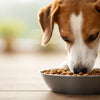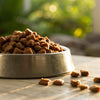How Many Calories Should a 75 lb Dog Eat? Understanding Your Dog's Nutritional Needs
- Houndsy
Table of Contents
- Introduction
- Understanding Calories and Their Importance
- Factors Influencing Caloric Needs
- Calculating Caloric Needs for a 75 lb Dog
- Practical Feeding Guidelines
- Creating a Feeding Schedule
- Common Myths About Dog Feeding
- Conclusion
- FAQ
Introduction
Have you ever found yourself gazing into your dog's soulful eyes while they eagerly await their meal, wondering if you’re feeding them the right amount? You’re not alone. Many pet parents grapple with the question of how many calories their furry companions need daily. For a 75 lb dog, this inquiry becomes essential for ensuring their health and vitality. Did you know that the Association for Pet Obesity Prevention estimates that 59% of dogs are overweight or obese? This statistic highlights the importance of understanding your dog's caloric needs to prevent health issues and maintain a healthy weight.
In this blog post, we will dive deep into the factors influencing your dog's caloric requirements, provide guidelines for determining how many calories a 75 lb dog should consume, and offer practical tips for feeding routines. By the end of this article, you will have a comprehensive understanding of your dog's nutritional needs and how to meet them effectively. So, let’s explore this vital aspect of pet care together!
Understanding Calories and Their Importance
Before we delve into specifics, let’s clarify what calories are and why they matter. Calories are a measure of energy content in food. Dogs derive energy from the macronutrients in their diet: proteins, fats, and carbohydrates. It’s crucial to strike a balance—too few calories can lead to weight loss and nutritional deficiencies, while too many can result in obesity and related health problems.
The energy a dog requires varies based on several factors including size, breed, age, activity level, and overall health. For our focus on a 75 lb dog, understanding these variables will help us determine their appropriate caloric intake.
Factors Influencing Caloric Needs
1. Body Weight
Weight is one of the most significant factors in determining caloric needs. Heavier dogs require more calories to maintain their energy levels compared to lighter dogs. For a 75 lb dog, we can use a standard formula to calculate their caloric requirements.
2. Activity Level
A dog’s daily activity level plays a crucial role in determining how many calories they need. Active dogs, such as those that enjoy long walks or play sessions, will require more energy than sedentary dogs. Here’s a quick breakdown:
- Sedentary: Minimal exercise, mostly lounging.
- Lightly Active: Daily short walks or playtime.
- Active: Regular exercise, such as running or agility training.
3. Age
Puppies and young dogs have higher energy requirements due to growth and development, while senior dogs typically require fewer calories. Adult dogs, like our 75 lb example, will have a consistent caloric need unless their activity levels change.
4. Health Status
Certain health conditions can affect a dog’s metabolism and caloric needs. For instance, a dog with a thyroid issue may require fewer calories due to a slower metabolism, while a pregnant or nursing dog will need significantly more.
Calculating Caloric Needs for a 75 lb Dog
To determine how many calories a 75 lb dog should eat, we can use the Maintenance Energy Requirement (MER) formula. The formula is as follows:
-
Convert weight to kilograms: [ \text{Weight in kg} = \frac{\text{Weight in lbs}}{2.2} = \frac{75}{2.2} \approx 34.1 \text{ kg} ]
-
Calculate the Resting Energy Requirement (RER): [ \text{RER (kcal/day)} = 70 \times (\text{Bodyweight in kg})^{0.75} ] [ \text{RER} = 70 \times (34.1)^{0.75} \approx 70 \times 17.5 \approx 1225 \text{ kcal/day} ]
-
Determine the Maintenance Energy Requirement (MER): For a moderately active dog, the multiplier is generally around 1.5 to 1.8. [ \text{MER} = \text{RER} \times \text{activity multiplier} ] Assuming an activity multiplier of 1.6 for a moderately active dog: [ \text{MER} = 1225 \times 1.6 \approx 1960 \text{ kcal/day} ]
Summary of Caloric Needs for a 75 lb Dog
- RER: Approximately 1225 kcal/day
- MER: Approximately 1960 kcal/day (for a moderately active dog)
Practical Feeding Guidelines
1. Choosing the Right Dog Food
The type of food you choose is crucial. High-quality dog food will provide the necessary nutrients and caloric content. Always check the feeding guidelines on the packaging, as they vary by brand and formulation.
2. Portion Control
Using a measuring cup helps ensure you’re feeding the correct amount. For instance, if your dog food contains 400 kcal per cup, you would calculate: [ \text{Cups per day} = \frac{\text{MER}}{\text{kcal per cup}} = \frac{1960}{400} \approx 4.9 \text{ cups} ] This means you would feed your dog approximately 4 to 5 cups of food each day, divided into two or three meals.
3. Monitoring Weight and Body Condition
Regularly monitoring your dog’s weight and body condition score (BCS) will help you adjust their food intake as necessary. An ideal BCS shows a defined waist and ribs that can be felt but not seen prominently.
4. Treats and Extras
Treats should make up no more than 10% of your dog's daily caloric intake. If your dog requires 1960 kcal, then treats should not exceed 196 kcal daily. Opt for low-calorie, healthy options, and always factor them into your dog's total daily calorie count.
Creating a Feeding Schedule
Establishing a consistent feeding schedule can aid digestion and help maintain a healthy weight. Here’s a suggested feeding routine for a 75 lb dog:
- Morning: 50% of daily food (approx. 2.5 cups)
- Evening: 50% of daily food (approx. 2.5 cups) This routine ensures your dog receives the right amount of calories throughout the day.
Common Myths About Dog Feeding
1. Dogs Can Eat Any Food
While dogs can eat a variety of foods, not all human food is safe for them. Certain foods, like chocolate, grapes, and onions, are toxic to dogs. Always consult your veterinarian before introducing new foods.
2. All Dogs Need to Eat the Same Amount
Every dog is unique. Factors such as size, age, and activity level will dictate their food intake. A 75 lb dog will have different needs compared to a smaller dog.
3. Once They’re Adult, They Don’t Need to Be Monitored
Just because a dog is an adult doesn’t mean their caloric needs remain static. Regularly assess their weight and adjust feeding amounts as necessary.
Conclusion
Understanding how many calories a 75 lb dog should eat is key to ensuring their health and longevity. By considering factors like activity level, age, and health status, you can determine their caloric needs and adjust their diet accordingly. Remember to choose high-quality food, monitor their weight, and establish a feeding routine to keep your furry friend happy and healthy.
If you’re looking for a convenient way to manage your dog's feeding routine, consider the Houndsy Kibble Dispenser. Its stylish design and ergonomic features make feeding time seamless and enjoyable. Explore our Houndsy Kibble Dispenser to enhance your pet care experience today!
FAQ
Q: How do I know if my dog is overweight? A: You can assess your dog's weight using a Body Condition Score (BCS) system. An ideal BCS shows a defined waist and ribs that can be felt but not seen prominently.
Q: Can I feed my dog homemade food? A: Yes, but it’s essential to ensure it meets all of your dog’s nutritional needs. Consult with your veterinarian to create a balanced diet.
Q: What should I do if my dog is gaining weight? A: Adjust their caloric intake and increase physical activity. Consult your veterinarian for personalized advice and weight management strategies.
Q: What is the best way to transition my dog to a new food? A: Gradually mix the new food with the old food over 7-10 days, increasing the new food amount gradually to avoid gastrointestinal upset.
By equipping yourself with this knowledge, you'll not only enhance the health of your beloved pet but also deepen the bond you share as you navigate the rewarding journey of dog ownership together.












